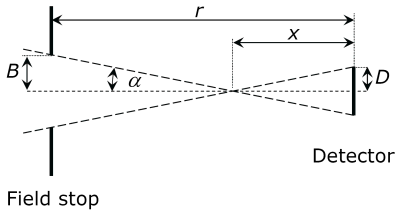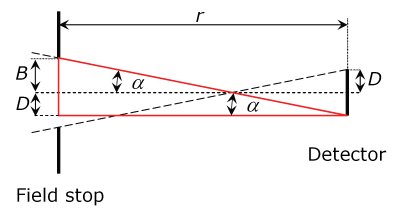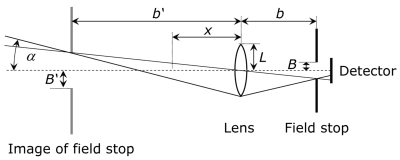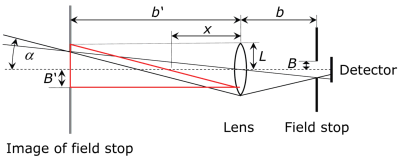5. Exercises
1. Light and Radiation
Electromagnetic Waves (2/4)
Question: Time lapse of sunlight and moonlight reaching the earth
a) The distance between the sun and the earth is approx. 150·106 km. How much time does it take (in seconds and in minutes) for the light emitted by the sun to reach the earth?
b) The distance between the moon and the earth is 384 000 km, hence much shorter. How much time does it take for the sunlight reflected by the moon surface to reach the earth?
Answer:
a) The time lapse of sunlight to reach the earth is
or 8.33 minutes.
b) For the moonlight it is
Question: The light year and the distance to Alpha Centauri
The closest star to the sun is called Alpha Centauri. Its distance is given as 4.247 light years. A light year is the distance travelled by light in one year, a unit of length often used in astronomy. How many kilometres is a light year? How far away in kilometres is Alpha Centauri? You will realise that light years are a very practical unit of length to avoid making distances to distant celestial bodies too unwieldy!
Answer:
A light year corresponds to the product of the speed of light and the time 1 year, i.e. the time 365 days with 24 hours, 60 minutes and 60 seconds each, i.e. 31.536·106 seconds.
or 9.461·1012 km or approx. 9.5 trillion kilometres. The distance of 4.247 light years to Alpha Centauri corresponds to approx. 40 trillion kilometres.
Electromagnetic Waves (4/4)
Worksheet: Light and radiation
Please test and deepen your knowledge on the topic of this chapter with the worksheet Light and Radiation. It can also be used as classroom task or homework assignment.
Photons (4/4)
Exercise: A flash of 1000 photons
In the dark of night, we see the flash of a camera far away. We assume that 1000 photons of the flash enter the retina through the pupil of our eye, a really very weak flash of light. In the left-hand column below it says that a dark-adapted eye can probably just barely perceive this flash.
The diameter of the pupil is 4 mm. The light wavelength is 500 nm (a flash is actually white). The flash duration is 1 ms, which corresponds to the flash duration of photo flashes.
a) Calculate the energy of a single photon in electron volts and of the flash consisting of 1000 photons in joules.
b) The photons are evenly distributed over the duration of the flash. What instantaneous power passes through the pupil?
c) What is the irradiance in W/m2 of the flash at our location?
Answers:
a) The energy of a photon is:
1 J corresponds to 1.6·10-19 eV. It becomes: E = 2.48 eV. Compare the result with the diagram on page Photons (3/4).
The total energy of the 1000 photons of lightning in the eye is 0.4·10-15 J or 0.4 fJ. (10-15 = 1 quadrillionth = 1 femto, abbreviation f)
b) The flash energy occurs in one millisecond. The power through the pupil during the flash duration is:
or 0.4 pW. (10-12 = 1 trillionth = 1 pico, abbreviation p)
It's hard to believe that the eye can see such lightning!
c) The radius of the pupil is r = 2 mm. The power passing through is 0.4·10-12 W. The irradiance is thus:
or 32 nW/m2. For comparison: In a cloudless sky, the irradiance on the ground at full moon is about 3 mW/m2, the sun at the zenith radiates with about 1 kW/m2.
Spectral analysis: Colour glass filters (4/4)
Exercise: Reflectances
Compare the black-and-white images of bands 1 to 4 with the false colour image.
- Evaluate the reflectances of vegetated and non-vegetated land surfaces and of the seawater based on their brightness.
- Have a look at the table of TM bands on the preceding page. Can you confirm the descriptions unter column characteristics?
- Investigate your findings further by comparing with information in related SEOS pages on
- spectroscopic characteristics of vegetation in tutorial Remote Sensing and GIS in Agriculture
- spectroscopic characteristics of seawater in the tutorial Ocean Colour in the Coastal Zone
- classificaton of satellite images in tutorial Classification Algorithms and Methods
No answers are suggested for this task.
Supplement 1.1: Maxwell's Equations
Question 1: Divergence and curl of a vector
Please show that the equations given above for the divergence and the curl of the electric field vector are correct. Are these terms scalar quantities or vectors?
Answers:
is a scalar,
is a vector. , and are the unit vectors in the direction of the , and coordinates.
Question 2: Gradient of a scalar quantity
To be complete, the ∇ operator can further be applied with scalar quantities. Let be a scalar function in space, e.g. the electric potential. The term ∇φ then denotes the spatial derivative of φ, also called grad φ. ∇φ is a vector since the vector ∇ is multiplied with the scalar φ.
Please write ∇φ in components along the x, y, and z directions.
Answer:
Supplement 1.2: The Laplace operator
In Cartesian coordinates, the nabla operator
is the first order spatial derivative. The scalar product is then the second order spatial derivative, the Laplace operator.
a) Please show that the Laplace operator in Cartesian coordinates is:
b) Please write the wave equation of the electric field in its components in Cartesian coordinates.
Answers:
a)
b) For the electric field of a wave in any direction is the x component:
and correspondingly for the y and z components and the magnetic field components.
Question 2: Third Maxwell equation in Cartesian components
Please show by calculus that the field vectors
applied to the third Maxwell equation yield the components:
Answer:
The third Maxwell equation
In components:
The assertion follows from this.
Supplement 1.4:
Energy and Irradiance of Electromagnetic Waves
Question 1: Electric and magnetic field of solar radiation
Chapter 2 Thermal radiation shows that the irradiance of solar radiation at the outer edge of the Earth's atmosphere is 1361 W/m², which is known as the solar constant. Please calculate the electric and magnetic field strength of this radiation.
Answer:
With , and follows:
The electric field is very strong, the magnetic field quite small. The cause is - as shown in the supplement - the relationship . However, the field energies of the electric and magnetic fields are the same.
The amplitude of a plane monochromatic wave is calculated here, which does not apply to solar radiation with its broad spectrum. The numerical values of the result are nevertheless valid, as spectral properties are not included in the calculation of the field strengths.
Supplement 1.6: Radiation pressure
Task 1: The radiation pressure of solar radiation
-
Chapter 3, section Climate and
climate change, shows that the irradiance of solar radiation at the outer edge of
the Earth's atmosphere is 1361 W/m²; this is the so-called solar constant.
How much is the radiation pressure of solar radiation?
Answer:
It is:
With and it follows: -
Reduced by absorption and scattering by the air molecules, around 65% of the solar
radiation present at the outer edge of the atmosphere reaches the earth's surface on
a cloud-free day. Compare the radiation pressure here with the air pressure at sea
level, which averages 1013 hPa.
Answer:
65% of the radiation pressure at the outer edge of the atmosphere results in at the earth's surface. 1013 hPa standard air pressure is 34·109 times greater in relation to this radiation pressure. The radiation pressure therefore plays no role for mechanical processes on the earth's surface.
-
The specific radiation of the sun's photosphere is likewise calculated in
Chapter 3, section Climate and
climate change.The photosphere is the area of the solar atmosphere in which the
solar radiation directed into space is generated. It amounts to 62.9 MW/m².
What is the value of the radiation pressure there?
Answer:
The corresponding calculation results in . The gas pressure of the sun's photosphere is 0.87 hPa at its upper edge and 125 hPa at its lower edge. Here, too, the radiation pressure plays only a minor role. -
Space agencies are investigating how radiation pressure can be used to propel
spacecraft. Although the acceleration achievable with a reflective solar sail is too
low for manned space flights, it should make long-term missions of small unmanned
satellites possible without additional propulsion.
One challenge is to develop materials for lightweight yet robust sails and the mechanical structures for their deployment in space. NASA's latest attempt (last access: 16 April 2025) aims to propel a probe with a total mass of 16 kg using an 80 m² sail. The Earth's orbit should be synchronised with the sun so that the sun illuminates the sail vertically at all times with the solar constant of 1361 W/m². Please calculate the achievable acceleration.
Answer:
It is
with the sail area and an ideally reflecting sail with the reflection coefficient , and with the mass of the satellite. The acceleration results in,a rather small value. Nevertheless, the speed has changed by 6.27 m/s after one day (after 86400 seconds).
Worksheet 1.2: Comet tails
Please supplement your knowledge of radiation pressure with worksheet 1.2: Comet tails.
Tasks: Comet tails
-
Calculate the ratio of gravity and force due to radiation pressure. What is the
dependence of the quotient on the density, the diameter and the distance to the sun?
Solution:
The ratio is proportional to the density and particle size. The distance to the sun is not important. -
Small ice crystals in the comet's tail have the density of water, i.e. approx. 1000
kg/m3. For what particle diameter do the force of radiation pressure and
gravity cancel each other out? Is the hypothesis correct that small particles are
repelled by radiation pressure and large particles are attracted towards the sun?
Solution:forThe hypothesis is correct. The critical size of absorbing particles at which both forces are equal is about 1 µm.
-
The particles in comet tails are obviously reflective rather than absorbent. How does
the diameter at which the two forces are equal change for ideally reflecting particles?
Solution:
The force exerted by the radiation pressure on ideally reflecting particles doubles, while the force of gravity remains the same. The critical particle size is therefore halved.
Supplement 1.7: Radiation quantities and radiometry
Task 1: The intensity of the sun's rays
The total radiant power of the Sun is 387.5·1024 W. The radiation is assumed to be directed isotropically into space. The distance between the Sun and the Earth is 149.589.000 km ((the so-called astronomical unit, AU). Because of this great distance, we can approximately view the sun as a point source of light from Earth. The radius of the Earth is 6371 km.
-
What is the radiant intensity of the sun's rays in outer space? What is the total intensity of the
rays hitting the Earth, or one square metre of the Earth?
Solution:
The radiant intensity of the sun's surface is:
For an isotropic emitter, the radiant intensity is constant, meaning that the radiant power changes proportionally to the solid angle. The radiant intensity that strikes the Earth as a whole and the radiant intensity for one square metre of the Earth therefore have the same value as the radiant intensity of the Sun into space.
-
Calculate the solid angle under which the Earth appears from the sun. How much
radiation power hits the Earth?
Solution:
Using the data for the Earth's radius and the distance between the Earth and the Sun, the solid angle , under which the cross-sectional area of the Earth appears from the Sun is given by:
Due to the isotropy of solar radiation, the following applies:
For the radiant power that strikes the Earth's cross-section, the following applies:
-
Calculate the solid angle at which one square metre of the Earth appears from the Sun, as well as the
radiant power falling on one square metre of the Earth. Compare the result with
the solar constant given in Chapter 3, which
corresponds to the irradiance at the outer edge of the Earth's atmosphere.
Solution:
The solid angle for one square metre of the Earth's surface is:
Once again, the following applies:
The radiant power is:
The solar constant is 1361 W/m². Within the accuracy of this estimate, the agreement is quite good.
Task 2: Isotropic emitters
-
Enlarge the solid angle of the cone oriented towards the zenith to a hemisphere (or: to
a half-space). What is the relationship between radiant power and radiant intensity?
Solution:
For a conical solid angle oriented towards the zenith, the azimuth angle varies from 0 to . The zenith angle varies from 0 to half the aperture angle :
For , .
-
Continue to enlarge the solid angle to the entire space and calculate the relationship again.
Solution:
For , . This result was already found at the beginning of the section on radiant intensity.
Task 3: Anisotropic emitters
The axially symmetrical radiant intensity of a lamp is given by
-
Please sketch the distribution of the radiant intensity over the zenith angle
ϑ from 0 to 180°.
Solution:
 Radiant intensity of the anisotropic emitter as a function of the zenith angleϑ.
Radiant intensity of the anisotropic emitter as a function of the zenith angleϑ. -
Calculate the total radiant power emitted as a function of the radiant intensity for
ϑ = 0.
Solution:
Task 4: Field of view of a detector with aperture
The detector and aperture are arranged at a distance r. The radius of the detector is D, the radius of the aperture is B. is the maximum possible half-field of view angle.
Using the geometric relationships, determine an equation for the visual field angle as a function of B and D.
Hint: Find a right-angled triangle that contains the angle and the radii B and D.
Solution:Task 5: Field of view of a detector with lens and aperture
The signal yield of a detector with an aperture is very low. Much better light yields can be obtained by adding a lens to the arrangement.
The maximum reception angle is determined by the lens (with radius L and focal length f) and the aperture at a distance b. The sensitive area of the detector behind the aperture should be large enough so that it does not limit the beam path. The largest possible half-field-of-view angle results from the image of the aperture B' at a distance b' from the lens.
a) Using the geometric relationships and the imaging equations for a lens, determine a relationship for the field of view angle as a function of L, B, b and f.
Hint: Again, find a right-angled triangle that now contains the angle and the quantities L, B' and b'. Use the lens imaging equations to represent the relationship as a function of B and b from B' und b'.
b) How is the result simplified for b=f, i.e. when the aperture is at the focal length of the lens?
Solution:a)
b)
Supplement 1.8: Lambert emitters, cosine emitters
Task 1: The radiant power of cosine emitters
An important group of anisotropic axially symmetric radiators are cosine emitters. Their radiant intensity decreases with increasing zenith angle ϑ in the range from 0 to according to cos ϑ:
Please calculate the radiant power of a cosine emitter in a conical solid angle with a maximum
zenith angle ϑ' and the radiant power in the upper half-space.
Solution:
The radiant power in the upper half-space:




